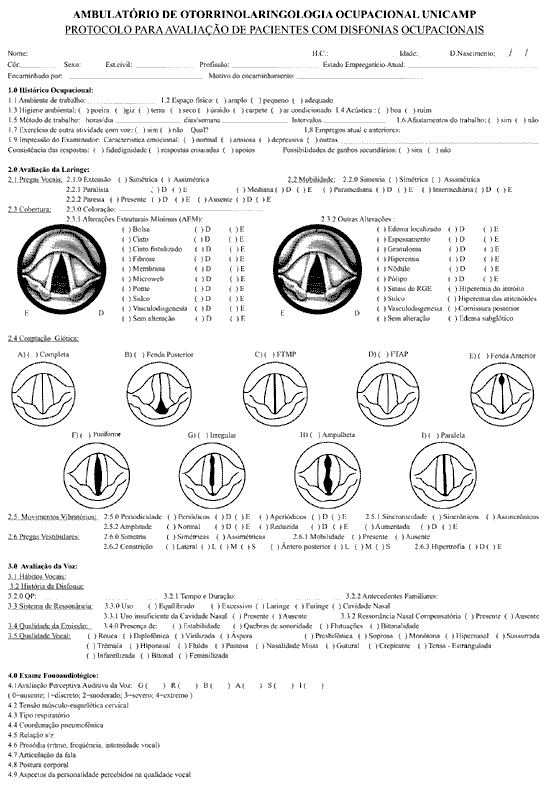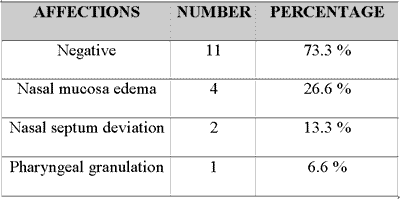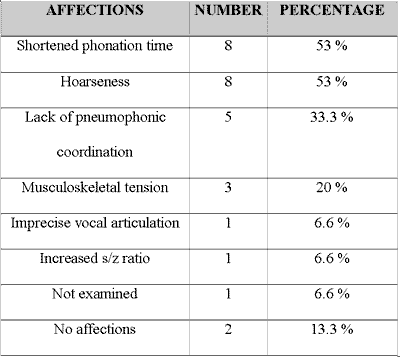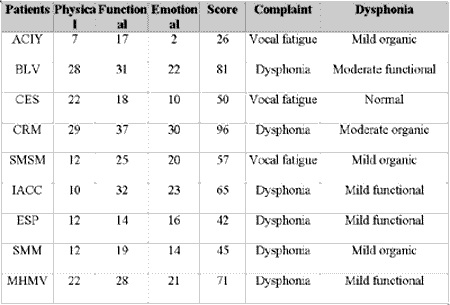

Year: 2004 Vol. 70 Ed. 5 - (2º)
Artigo Original
Pages: 590 to 596
Proposal for Multidisciplinary Protocol for Occupational Dysphonia: preliminary study
Author(s):
Erica Ortiz1,
Everardo A. de Costa2,
Ana Lúcia Spina3,
Agricio N. Crespo4
Keywords: dysphonia, occupational, multidisciplinary.
Abstract:
Dysphonia has an occupational view nowadays. A shift in the voice-oriented professional's clinical approach has been required. New voice-oriented job categories have emerged and, as a result, the voice disorder in the professional enviroment has increased. The economic and productivity harm due to voice disorders are a preocupation. Dysphonia has multiple causes and its evaluation, ethiological conclusion and occupational reports aren't defined yet. In order to obtain a more accurate and comprehensive evaluation, a multidisciplinary protocol was elaborated to ensure proper medical scientific support. It consists of anamnesis, physical exam, laryngeal endoscopy, perceptive voice analysis and Voice Handicap Index application (VHI). In this preliminary study, the protocol was applied on 15 voice professionals with dysphonia. Results: 13,3% with normal voice performance; 33,3% with functional dysphonia; 46% with organic dysphonia. Dysphonia was related to the voice-oriented job in 40% cases and it was ruled out in 46,6%. We concluded that the protocol is complete enough to help otolaryngologists evaluate this workers' category.
![]()
INTRODUCTION
In past years, laryngology has shown interest in professional voice use, especially in teachers and singers. It is observed that there is higher likelihood of development of dysphonia in such professional groups, even though the prevalence and incidence are extremely variable, ranging from 3 to 90%.1,2,3,4,5,6
Studies have been frequently directed to clinical and organic aspects of dysphonias in people that use their voices professionally. There is evidence that vocal fold nodules is the most frequent disease in these professionals, but there is a wide range of other organic and functional laryngeal and respiratory affections that can also cause dysphonia2. Dysphonias have multifactor causes and it is difficult to relate them to one single cause.
Preventive actions should be adopted as integral care provided to these professionals. However, workers are not normally instructed about vocal functioning and care required to reduce the risk of developing dysphonia. Vocal care is common among singers and actors, but not among teachers or others.
Currently, technology development, change in social-cultural profile and world globalization require greater use of oral communication and, consequently, vocal use at work. Thus, there are new categories of jobs, such as telemarketing operators, for example. There has been a diversification of professional categories that use their voice professionally and the concept of professional voice user is further expanded, in which we can include workers such as preachers, salespeople, radio narrators, journalists, politicians, actors and others under this umbrella of voice users at work. There is a shift from clinical focus of dysphonia to a more directed occupational view. People who use their voice at work are more concerned about their work capabilities and the economic loss generated by dysphonia. Otorhinolaryngologists are visited to treat dysphonias and to produce reports that indicate occupational "capability" or "disability". Dysphonia is not listed as an occupational disease and there are no clearly defined legal regulations that relate vocal affection and work.
Therefore, dysphonia stills causes some polemics, making it a complex topic and increasing the need for further understanding from the occupational level. The main controversy between voice and work generates discussions in the international arena of Otorhinolaryngology so as to try to have a conciliation of issues without harming both employee and employer. Occupational focus overrules the organic one, but it is extremely difficult to related dysphonia directly to the actual work. We need objective parameters to be applied in this area.
The present study aimed at presenting a model of protocol for patients with dysphonia of alleged occupational origin and a preliminary study with 15 patients that used their voice as a work tool. This presentation aims at providing information to Otorhinolaryngologists and direct data collection from clinical history, physical examination and support tests to better manage these patients.
MATERIAL AND METHOD
We developed a management protocol for patients with dysphonia from possible occupational origin at the Ambulatory of Laryngology, Discipline of Otorhinolaryngology, FCM/UNICAMP. It comprises clinical-occupational history directed to vocal abnormalities and information about vocal use at work, basic ENT examination (oroscopy, rhinoscopy, otoscopy), flexible and rigid fibrolaryngoscopy, and perceptual vocal analysis.
We also used an adaptation to Portuguese of Voice Handicap Index (VHI, Jacobson et al., 1997). The adaptation comprises 30 questions subdivided into three blocks of 10. The first block analyzes patients' complaints under the physical perspective and vocal alterations as perceived by the patients. The second block assesses emotional aspects of dysphonia, inter-relational issues caused by vocal alteration. The third aspect - functional area - shows the effects of dysphonia on daily activities. To each item, there are 4 response options (never, rarely, frequently, always) and scores are calculated by adding up responses in each block.To carry out a preliminary analysis, we performed a retrospective and descriptive study of the medical charts of 15 patients from the Ambulatory of Occupational Otorhinolaryngology seen between May 2001 and April 2002. They were workers who came to our center complaining of dysphonia owing to professional vocal use. Since it was a medical chart review without individual identification, subjects were not asked to authorize use of data in the study, but their personal identification has been maintained confidential.
Out of the examined sample, there were 4 men and 11 women. Mean age was 35 years (from 20 to 63 years). Nine (60%) were teachers, two (13%) were Telemarketing operators, one was (6%) a machine operator, one was (6%) an event promoter, one (6%) was a secretary, and one (6%) worked with industrial washing. Teachers taught for elementary school (six), primary school (three) and one was a physical education teacher at a private gym. Time in the job, average working hours and rest intervals are shown in Tables 1, 2 and 3, respectively.
RESULTS
In the studied sample, the workplace aggravated vocal quality because of poor ventilation and cleaning conditions; excessive environmental noise; chalk and dust; very large rooms with poor acoustic conditions; air-conditioned; presence of carpets and chemicals. Only one of the teachers reported exposure to chemicals outside the workplace.
They all denied vocal abuse after work, except for the industrial washing worker who participated in the church choir.
The main symptoms were dysphonia (86%) and vocal fatigue (60%).
Depression, allergic rhinitis, temporomandibular disorder and smoking were the most frequently found clinical history data, but in small percentage (13.3%, each one). They also reported personal history of sinusitis, gastritis, hyperthyroidism, drug treatment for weight loss and laryngeal microsurgery for Reinke's edema.
There were two patients with history of dysphonia in the family, whose family members were also teachers. Only one patient had an asthmatic relative and another one had a relative with cardiopathy. The other patients did not report related family history.
The basic ENT examination was within the normal range in 11 (73.3%) patients.
Fibrolaryngoscopy was within the normal range in two patients (13%).
Speech and vocal assessment concluded that 12 patients (80 %) presented vocal alterations. Perceptual analysis could not be performed in one patient because she did not participate.
VHI was applied in 9 patients only. Total score of VHI ranged from 26 to 96. The lowest score (26) was of a patient with organic-functional dysphonia with vocal fold nodules, adapted voice and complaints of vocal fatigue. The highest score (96) was found in a patients with organic-functional dysphonia caused by possible vocal sulcus and vocal fold cyst and she complained of dysphonia and had no clinical improvement with vocal therapy.
Final medical report concluded that two subjects (13.3%) presented normal exams, seven (46.6%) had organic-functional dysphonia, five (33.3%) presented functional dysphonia, and one was non-conclusive because she refused to complete the tests.
DISCUSSION
According to the literature, there is higher frequency of vocal affections in female patients 3,5,6,7,8. There are studies that demonstrate the occurrence of significant changes in glottic configuration of women during prolonged phonation with high loudness level, possibly caused by constitutional and anatomical differences 9. There is also higher female predominance because the pedagogical area seems to have more female representatives. This proportion may change as a result of the development of other professional categories. In our sample, even though small, there was predominance of female subjects.
The expansion of professional voice concept can be perceived in this small sample. Despite predominance of teachers, we found jobs that have not been commonly related with vocal alterations, such as event promoters, industrial washing worker, machine operator and secretary. It is known that many people use their voices as work tool. However, there is no standardization concerning optimal vocal use at work. Professional voice users cannot be grouped under one single category owing to the diversity of each area. Costa et al. suggested subcategorization of these professionals to better manage and understand these professions and vocal use 10. Labor factors demand, working hours and intervals should be included in professional categorization when we are dealing with occupational voice use 7, 8, 11. In the small sample studied by us, it was not possible to assess this variable.
Time in the job demonstrated the diversity of vocal behavior in different areas. Apparently, vocal dysfunction has on average late onset among school teachers (14 years). In 1997, Smith et al. showed that vocal affections among teachers happened after 10-20 years in the job 5. However, physical education teachers presented high frequency of acute vocal dysfunction, 86% of the cases, caused by hard vocal attack and high intensity 4. Conversely, Telemarketing operators have early dysphonia (6 months). We may infer that emotional and environmental stress, demand and profile of this work group may favor early affections 1. The same occurred with a small contingence of subjects reported here.
Work environment may influence professional performance, sometimes negatively. The most frequent complaints are: environmental noise, dust, cleaning products, air-conditioned. A research study conducted at PUC-SP concluded that ergonomics may also be considered an occupational risk 12,13.
History and personal data are important to relate dysphonia and work. In our sample, the most frequent symptom was dysphonia and not vocal fatigue, as observed by the literature 1,2,3,5,6,14. However, we should also take into account extra-work vocal abuse, allergic symptoms, gastroesophageal reflux, psychiatric disorders and habits (smoking) 15, 16.
The physical examination showed that 73.3% of the patients presented otoscopy, oroscopy and rhinoscopy within the normal range; 13.3% of laryngeal fibroscopy did not show abnormalities and 20% of vocal perceptual analyses were also considered normal. We concluded that ENT examination only is not enough to confirm the diagnosis, even with fibrolaryngoscopy, since some studies show that adapted larynges with appropriate voice can present structural affections 17, 18. For this reason, we should always perform perceptual or acoustic assessment with these patients.
In our small group, there was higher frequency of vocal fold nodules in women, as described by the literature 2. We should not exclude vocal abuse as the genesis of dysphonia, knowing that its influence is present and it is associated with previous anatomical and structural conditions 1,7,9,11,19.
It was observed that five patients (33%) had functional dysphonia caused by musculoskeletal tension and lack of pneumophonic coordination. In three of these patients, dysphonia was related to work. Conversely, out of 7 patients with organic-functional dysphonia (46%), dysphonia was associated with labor in three of them. In summary, it was possible to associate the cause of dysphonia with work activities in only six subjects (40%), in seven cases (46.4%) it was not possible to characterize this correlation, and in other two (13.3%), the correlation was questionable, because there was incompatibility between symptomatology, physical examination and vocal assessment.
Thus, there is no defined pattern to establish cause-relation of dysphonia and work conditions. Therefore, we used as reference the General Regulation of Social Welfare, Law Nº 8.213/91, Article 20, which conceptualizes Occupational Disease as any affection triggered or worsened because of the special conditions in which work is performed or related to 20. In the series of technical reports issued by WHO (1985), dysphonia is considered a multifactor disease related to work 21. We should not exclude use of voice at work as a factor that contributes to the onset of vocal dysfunctions. However, we should carefully and deeply investigate data from history, physical examination, laryngoscopy and vocal perceptual analysis to be able to define occupational correlation. We should highlight the case of the machine operator in the sample that stated that dysphonia was work-related but his history showed chronic smoking and laryngoscopic examination revealed marked edema of vocal folds. Upon preparing the report on this case, it was easy to exclude the correlation between dysphonia and work. However, we were not sure about teachers and telemarketing operators who had strangled voice without significant laryngeal affections and inconsistency in vocal perceptual analysis. It is widely known that emotional status is closely related with dysphonia and some studies indicate the possibility of having involuntary somatization in cases such as these 22. It is also known that in some few cases, such as in occupational hearing loss cases, there can be malingering of the condition. In dysphonia patients, evidence of such fact is neither clearly nor objectively measurable.
We do not count on legal support to state labor disability of such patients. Therefore, saying that dysphonia is a disabling condition to work may generate conflicts for patients themselves. In 2001, Sattaloff et al. proposed the classification of professional voice users to define disabling vocal dysfunction 23. They based their classification on the concepts of "disability" and "handicap" and adapted them to vocal and speech affections, dividing the assessment into audibility, intelligibility and functionality parameters. They also reported the need to determine disability of dysphonic patients based on subjective and objective parameters, assessing the occupational routine of patients.
In the first consensus on professional voice, it was estimated that 100 million reais are spent every year by the local-level school system in Brazil because of medical leaves for teachers 24. Without legal support, occupational approach of dysphonia may generate unimaginable damage. However, advocacy of legal strategies is the last step to take, since there are still some scientific issues to be clarified concerning professional voice use.
VHI showed great variability even among diseases similarly classified, demonstrating how dysphonia can influence different aspects of the work routine of patients. Curiously, emotional aspect received smaller scores except in one patient, whereas higher scores were given to functional aspect. We can understand that dysphonia causes greater functional impact in the routine of these professionals and, consequently, reduce their productivity. Dysphonia was scored the highest, and organic dysphonia was the cause of most impact on the lives of patients. The intensity of the complaint was compatible with VHI score, but we did not conduct statistical analysis owing to the small sample size. We intend to expand the number of subjects and observe the application of the method in the Brazilian population25,26.
In our study, we recommended clinical management, vocal therapy and/or surgery to each specific case after joint deliberation of ENT, occupational physicians and speech and hearing therapists. The patients were not classified as disabled because none of them had severe dysphonia. It was concluded that if patients followed vocal hygiene guidelines and treatment approach, they would be able to keep on working without risk of getting worse. It is known that when voice is adapted, there is no impairment of phonation organ and even if there are minimum structural alterations or intracordal cysts, professionals can play their roles without organic or phonation impairment. Similarly, we did not suggest medical leave to workers, especially because the continuation of work routine is necessary for appropriate adaptation to work conditions and effective treatment. Managing patients that are away from work is easier, but ineffective. This kind of management approach goes against the current legislation that recommends workers to be away from risk agents if the diseases were triggered or worsened by work conditions 20. However, in the case of work-related dysphonia, this rule is inappropriate.
CONCLUSION
We presented a management protocol to patients with vocal disorders related to work as clinical-occupational assessment tool of dysphonia to be used by Otorhinolaryngologists. The use of VHI can complement the assessment of emotional, physical and functional impacts caused by dysphonia and support the conclusion of the cases.
We conducted a preliminary study in 15 patients with dysphonia related to work conditions, according to them. In six cases it was possible to define a correlation between dysphonia and work and in seven, there was no correlation between the two elements.
The use of these instruments proved to be useful and comprehensive, but they should be applied to a larger number of subjects and professional categories. Based on this assessment model, Otorhinolaryngologists will have significant data to prepare relevant reports and to adopt really effective management approaches.
REFERENCES
1. Gotaas C, Starr C. Vocal fatigue among teachers. Folia Phoniatr 1993; 45:120-9.
2. Mattiiske JA, Oates JM, Greenwood KM. Vocal problems among teachers: review of prevalence, causes, prevention and treatment. J Voice 1998; 12(4): 489-99.
3. Russell A, Oates J, Greenwood KM. Prevalence of voice problems in teachers. J Voice 1998; 12(4): 467-79.
4. Smith E, Lemke J, Taylor M, Kirchner HL, Hoffman H. Frequency of voice problems among teachers and other occupations. J Voice 1998; 12(3): 480-8.
5. Smith E, Gray SD, Dove H, Kirchner L, Heras H. Frequency and effects of teachers' voice problems. J Voice 1997; 11(1): 81-7.
6. Smith E, Lemke J, Taylor M, Kirchner HL, Hoffman H. Voice problems among teachers: differences by gender and teaching characteristics. J Voice 1998; 12(3): 328-34.
7. Garcia OC; Torres RP, Shasat ADD. Dysphonias ocupacionales; estudio de 70 casos. Rev Cub Med 1986; 25: 998-1009.
8. Giampieri NIC. La voz em el campo ocupacional. Salud Ocupac 1992; 10(49): 29-31.
9. Linville SE. Changes in glottal configuration in women after loud talking. J Voice 1995; 9(1): 57-65.
10. Costa HO, Duprat A, Eckley C, Silva MAA. Caracterização do profissional da voz para o laringologista. Rev Bras Otorrinolaringol 2000; 66(2): 129-34.
11. Penteado RZ, Pereira IMTB. A voz do professor: relações entre trabalho, saúde e qualidade de vida. Rev Bras Saude Ocup 1999; 25(95/96): 109-30.
12. Ferreira LP, Figueira S. Dysphonia como Doença do Trabalho. XI Seminário de Voz PUC/SP, 2001.
13. Ferreira LP. Ensinar causa alteração de voz. Proceedings Proteção 2000; 22.
14. Kostyk BE, Rochet AP. Laryngeal airway resistance in teachers with vocal fatigue: a preliminary study. J Voice 1998; 12(3): 287-99.
15. Mitchell SA. Medical problems of professional voice users. Compr Ther 1996; 22(4): 231-8.
16. Sattaloff RT, Spiegel JR. Care of professional voice. Otol Clin N Am 1991; 24(5): 1093-123.
17. Elias ME, Sattaloff RT, Rosen DC, Heuer RJ, Spiegel JR. Normal strobovideolaryngoscopy: variability in health singers. J Voice, 1997; 11(1): 104-7.
18. Oliveira I.B. Desempenho vocal do professor: avaliação multidimensional; 1999. Tese, PUCCAMP, Campinas; 1999.
19. Buekers R, Bierens E, Kingma H, Marres EHMA. Vocal load as measured by the voice accumulator. Folia Phoniatr 1995; 47: 252-61.
20. BRASIL - Lei Nº 8.213, de 24/07/1991 - Dispõe sobre os Planos de Benefícios da Previdência Social e Dá Outras Providências. (D.O.U. 25/07/1991)
21. Brunetto B, Oyarzun R, Mella L, Avila S. Mitos y realidades de la dysphonia professional. Ver Otorrinolaring 1986; 46: 115-20.
22. Millar A, Deary IJ, Wilson JA, Mackenzie K. Is an organic/functional distinction psychologically meaningful in patients with dysphonia? J Psychosom Res 1999; 46(6): 497-505.
23. Sattaloff RT, Abaza MM. Impairment, disability and other medical-legal aspects of dysphonia. Otol Clin N Am 2000; 33(5): 1143-53.
24. BRASIL - 1ª Reunião Pró-Consenso nacional sobre Voz Profissional. Sociedade Brasileira de laringologia e Voz. Rio de Janeiro, 6-7/04/2001.
25. Klein S, Piccirillo JF, Painter C. Comparative contrast of voice measurements. Otol Head Neck Surg 2000; 123:164-9.
26. Murry T, Rosen CA. Outcome measurements and quality of life in voice disorders. Otol Clin N Am 2000; 33(4): 905-17.Table 1. Time in the job. Table 2. Daily working hours (average).
Table 2. Daily working hours (average). Table 3. Rest interval during the workday.Table 4. Referred symptoms (N=15).
Table 3. Rest interval during the workday.Table 4. Referred symptoms (N=15).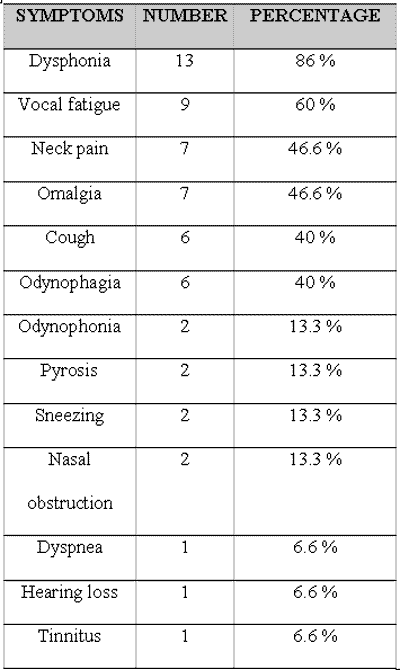
Table 5. Basic ENT examination (N=15).Table 6. Fibrolaryngoscopic exam (N=15).Table 7. Vocal perceptual analysis (N=15).Table 8. Voice Handicap Index, main complaint and type of dysphonia.
* Otorhinolaryngologist, Collaborator at Discipline of Otorhinolaryngology and Head and Neck Surgery, FCM/UNICAMP.
** Ph.D., Professor, Discipline of Otorhinolaryngology and Head and Neck Surgery; Program of Post-Graduation in Collective Health, FCM/UNICAMP.
***Speech and Hearing Therapist, Master in Biomedical Sciences, Discipline of Otorhinolaryngology and Head and Neck Surgery, FCM/UNICAMP
**** Ph.D., Professor, Head of Discipline of Otorhinolaryngology and Head and Neck Surgery, FCM/UNICAMP.
Address correspondence to: Erica Ortiz, Disciplina de Otorrinolaringologia - FCM UNICAMP
Caixa Postal 6111
CEP13081-970
Email: erica.ortiz@terra.com.br
